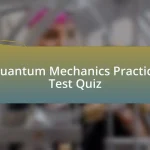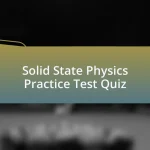Start of Optics and Light Practice Test Quiz
1. Light is composed of waves and particles called:
- rays
- photons
- particles
- waves
2. The visible spectrum of light from the longest to shortest wavelength is:
- C red, orange, yellow, green, blue, indigo, violet
- B green, blue, yellow, red, orange, violet
- A violet, blue, green, yellow, orange, red
- D orange, yellow, red, violet, green, blue
3. The speed of light in a vacuum is:
- 150,000 km/s
- 500,000 km/s
- 300,000 km/s
- 1,000,000 km/s
4. When light rays reflect off a plane mirror, the angle of incidence:
- is always less than the angle of reflection
- is independent of the angle of reflection
- is twice the angle of reflection
- equals the angle of reflection
5. The bending of light as it travels from one medium to another is:
- C refraction
- D absorption
- A reflection
- B diffraction
6. When a light travels from a more dense material such as glass to a less dense material such as air, the light ray refracts:
- straight through
- away from the normal line
- in a circular path
- towards the normal line
7. When a light ray refracts from air to water, the angle of refraction is:
- opposite to the angle of incidence
- less than the angle of incidence
- equal to the angle of incidence
- greater than the angle of incidence
8. A transparent object with flat surfaces that is used to separate the visible light spectrum into its different colours is called a:
- prism
- filter
- lens
- mirror
9. When light rays travel at a critical angle through an object such as optical fibre, they are:
- reflected at a right angle
- partially absorbed
- completely refracted
- totally internally reflected
10. An image is called real or:
- direct
- inverted
- reflective
- virtual
11. An upside down image is called:
- reflected
- inverted
- distorted
- virtual
12. A magnifying glass is an example of a:
- concave lens
- flat mirror
- opaque object
- convex lens
13. Convex lenses converge light rays to a:
- divergent point
- focal point
- virtual image
- real image
14. An example of a diverging lens that spreads light rays is the:
- A convex lens
- B concave lens
- C flat lens
- D plano-convex lens
15. An object under white light which reflects green light and absorbs the other six colours of the spectrum will appear the colour of:
- red
- blue
- yellow
- green
16. The absolute index of refraction for a substance is 2.0 for light having a wavelength of 5.9 x 10^-7 meter. In this substance what is the critical angle for light incident on a boundary with air?
- 75 degrees
- 45 degrees
- 30 degrees
- 60 degrees
17. Which phenomenon can occur with light, but not with sound?
- refraction
- polarization
- reflection
- diffraction
18. The threshold frequency of a photo emissive surface is 7.0 x 10^14 hertz. Which electromagnetic radiation, incident upon the surface, will produce the greatest amount of current?
- high intensity UV radiation
- infrared radiation
- visible light radiation
- radio wave radiation
19. A spherical mirror that forms only virtual images has a radius of curvature of .5 meters. The focal length of this mirror is:
- -0.5 m
- 1.0 m
- 0.25 m
- -0.25 m
20. A spherical concave mirror is used in the back of a car headlight. Where must the bulb of the headlight be located to produce a parallel beam of reflected light?
- at the mirror`s surface
- in front of the mirror
- beyond the center of curvature of the mirror
- at the focal point of the mirror
21. An object .080 meter high is placed .20 meter from a converging (convex) lens. If the distance from the image of the lens is .40 meter, the height of the image is:
- .32 m
- .08 m
- .20 m
- .16 m
22. A diverging (concave) lens can form images that are:
- inverted, only
- real, only
- virtual, only
- real and virtual
23. A ray of light strikes a plane mirror at an angle of incidence equal to 35 degrees. The angle between the incidence ray and the reflected ray is:
- 35 degrees
- 70 degrees
- 45 degrees
- 105 degrees
24. Compared to the wavelengths of visible light the wavelengths of UV light are:
- equal
- inverted
- shorter
- longer
25. What is the energy of a quantum of light having a frequency of 6.0 x 10^14 hertz?
- D 8.0 x 10^-19 J
- A 2.4 x 10^-19 J
- C 1.2 x 10^-19 J
- B 4.0 x 10^-19 J
26. Experiments performed with light indicate that light exhibits:
- D neither wave nor particle properties
- A only wave properties
- B only particle properties
- C both particle and wave properties
27. What is the speed of light in a medium having an absolute index of refraction of 2.3?
- 4.0 x 10^8 m/s
- 2.0 x 10^8 m/s
- 1.3 x 10^8 m/s
- 3.0 x 10^8 m/s
28. Define total internal reflection.
- Total internal reflection is when light changes speed but does not change direction as it moves through a single medium.
- Total internal reflection is the process where light is absorbed by the medium instead of being reflected.
- Total internal reflection occurs when a light beam strikes the boundary at an angle greater than the critical angle, causing all light to be reflected back into the medium.
- Total internal reflection happens when light passes from a denser to a less dense medium and refracts completely out.
29. Which among the following is the property of light?
- C only diffraction
- D all the options (refraction, diffraction, reflection, total internal reflection)
- A only reflection
- B only refraction
30. Dispersion can be observed through:
- filter
- mirror
- prism
- lens
Congratulations! You’ve Successfully Completed the Optics and Light Quiz
Thank you for participating in the Optics and Light Practice Test. Completing this quiz is a significant step in reinforcing your understanding of key concepts in physics. You’ve likely gained insights into the behavior of light, including reflection, refraction, and the properties of lenses. These principles are foundational in both theoretical and practical applications of physics.
As you worked through the questions, you may have discovered areas where your knowledge was strong and others that might need further exploration. This quiz serves not only as a tool for assessment but also as an engaging way to visualize how light interacts with matter. Understanding these concepts is essential for problem-solving in various physics scenarios, from daily life observations to advanced scientific studies.
We invite you to advance your learning by checking out the next section on the page, which delves deeper into the topic of Optics and Light. There, you’ll find a wealth of resources designed to expand your knowledge and enhance your readiness for any upcoming physics tests. Let’s continue this journey of learning together!
Optics and Light Practice Test
Understanding Optics: Fundamentals of Light Behavior
Optics is the branch of physics that studies the behavior and properties of light. It examines phenomena such as reflection, refraction, diffraction, and interference. Understanding how light interacts with various materials is essential for mastering optics. These principles form the foundational concepts needed for advanced topics, such as lenses and optical instruments.
Types of Optical Instruments: Key Equipment in Physics
Optical instruments manipulate light to aid in observation and analysis. Common types include telescopes, microscopes, and cameras. Each instrument utilizes lenses or mirrors to focus and magnify images. Familiarity with these instruments and their functions is crucial for physics tests that involve practical applications of optics.
Lens Formula and Applications: Solving Problems in Optics
The lens formula relates the object distance, image distance, and focal length of lenses. It can be expressed as 1/f = 1/v – 1/u, where f is the focal length, v is the image distance, and u is the object distance. This formula is essential for solving problems related to image formation by both converging and diverging lenses, critical for any optics practice test.
Wave-Particle Duality of Light: Core Concept in Physics
Wave-particle duality describes how light exhibits both wave-like and particle-like properties. This duality is fundamental to modern physics, influencing concepts such as quantum mechanics and the photoelectric effect. Understanding this concept is vital for tackling advanced questions on optics, as it impacts theories of light propagation and interaction with matter.
Calculating Optical Power: Practical Skills for Physics Exams
The optical power of a lens is the inverse of its focal length, expressed in diopters (D). Power is calculated using the equation P = 1/f, where f is in meters. Mastery of this calculation allows students to determine lens strengths, key for practical lab applications and theoretical questions on exams.
What is an optics and light practice test?
An optics and light practice test is an assessment tool designed to evaluate a student’s understanding of concepts related to optics, such as reflection, refraction, lenses, and the behavior of light. These tests typically include multiple-choice questions, problem-solving exercises, and diagrams. They often cover fundamental principles from physics courses, ensuring that students can apply theoretical knowledge to practical scenarios.
How can students prepare for an optics and light practice test?
Students can prepare for an optics and light practice test by reviewing their course materials, such as textbooks and lecture notes focused on optics concepts. Practicing with previous exams and solving sample problems enhances understanding. Additionally, utilizing online resources and simulations that demonstrate optical phenomena can reinforce learning. Engaging in study groups can also be beneficial, allowing students to discuss and clarify complex topics.
Where can students find optics and light practice tests?
Students can find optics and light practice tests in several locations, including online educational platforms, physics textbooks that include practice questions, and university course websites. Many educational institutions provide past exam papers and study guides specifically for optics. Websites like Khan Academy and other academic resources may also offer practice problems and quizzes related to light and optics.
When should students take practice tests for optics and light?
Students should take practice tests for optics and light during their study sessions leading up to actual exams. It is effective to take these tests after completing relevant coursework or sections within their syllabus. Doing so helps to reinforce knowledge and identify areas that require further review. Regularly scheduling practice tests can improve retention and boost confidence before the main examination.
Who benefits from taking optics and light practice tests?
Students enrolled in physics courses, particularly those focusing on light and optics, benefit from taking practice tests. This includes high school and college students preparing for exams. Additionally, educators can use these tests to gauge student comprehension and readiness for advanced topics. Ultimately, anyone studying the principles of optics can gain a deeper understanding through consistent practice and assessment.















